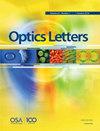时空光学涡旋的时间几何自旋霍尔效应。
IF 3.3
2区 物理与天体物理
Q2 OPTICS
引用次数: 0
摘要
本文揭示了光的时间几何自旋霍尔效应(TGSHEL),这是一种时空光涡旋(stov)的新现象。通过洛伦兹变换,我们展示了stov的能量中心如何经历与传统几何自旋霍尔效应(GSHEL)不同的横向位移。我们的理论见解得到了数值模拟的证实,表明TGSHEL随着速度和拓扑电荷的增加而放大。我们阐明了TGSHEL的物理基础,将位移与内在和外在轨道角动量之间的相互作用联系起来。TGSHEL的发现丰富了我们对光在时空中的几何性质的理解。本文章由计算机程序翻译,如有差异,请以英文原文为准。
Time geometric spin Hall effect of a spatiotemporal optical vortex.
The paper unveils the time geometric spin Hall effect of light (TGSHEL), a new phenomenon of spatiotemporal optical vortices (STOVs). Through the Lorentz transformation, we demonstrate how the energy center of STOVs experiences a transverse displacement that is distinct from the conventional geometric spin Hall effect of light (GSHEL). Our theoretical insights are corroborated by numerical simulations, revealing that the TGSHEL amplifies with increased velocities and topological charge. We elucidate the physical basis of TGSHEL, linking the displacement to the interaction between intrinsic and extrinsic orbital angular momentum. The discovery of TGSHEL enriches our comprehension of light's geometric properties in space-time.
求助全文
通过发布文献求助,成功后即可免费获取论文全文。
去求助
来源期刊

Optics letters
物理-光学
CiteScore
6.60
自引率
8.30%
发文量
2275
审稿时长
1.7 months
期刊介绍:
The Optical Society (OSA) publishes high-quality, peer-reviewed articles in its portfolio of journals, which serve the full breadth of the optics and photonics community.
Optics Letters offers rapid dissemination of new results in all areas of optics with short, original, peer-reviewed communications. Optics Letters covers the latest research in optical science, including optical measurements, optical components and devices, atmospheric optics, biomedical optics, Fourier optics, integrated optics, optical processing, optoelectronics, lasers, nonlinear optics, optical storage and holography, optical coherence, polarization, quantum electronics, ultrafast optical phenomena, photonic crystals, and fiber optics. Criteria used in determining acceptability of contributions include newsworthiness to a substantial part of the optics community and the effect of rapid publication on the research of others. This journal, published twice each month, is where readers look for the latest discoveries in optics.
 求助内容:
求助内容: 应助结果提醒方式:
应助结果提醒方式:


